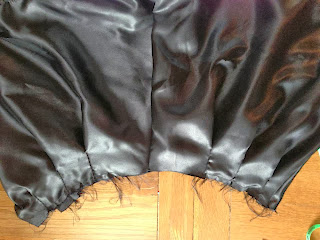So, after my last attempt to get vintage style curls, which went reasonably well (see http://vintagesallyblog.blogspot.co.uk/2013/09/the-eternal-quest-for-curls-product.html ), I then went and got my hair cut. Slightly too short. Ooops. This meant I wasn't sure that my previous method of using big foam rollers would work, so I decided to try out another couple of methods.
My hair is now, theoretically, the perfect length for vintage styles of this era - or it would be if it would hold a curl at all, wherein lies the problem.
With shorter hair I thought I would need tighter, more defined curls than the big foam rollers gave me. I had at least had the sense to make sure my hairdresser didn't cut any modern style layers into my hair, which look great with modern straight styles but don't leave enough to curl.
My first test was a proper 1930s finger waves and pin curls style, following the instructions in the wonderful Style Me Vintage Look Book http://www.amazon.co.uk/Style-Vintage-Step-Step-Retro/dp/1862059764
First I washed my hair, towel dried it, and sprayed it with lots of setting lotion until it felt pretty damp again:
 |
| Towel dried hair |
 |
| A liberal spraying of setting lotion |
I have never been good at manipulating my hair, for which I usually blame my uncooperative hair but is probably a lot due to my own incompetence too. I started trying to put the finger waves into the top of my hair, but it took quite a lot of goes to get it right. I found that with my hair, they seemed to work better with hair pins than with hair dressing clips:
 |
| Trying to get the clips in straight. Yes, this is harder when you're trying to take a photo f yourself at the same time! |
 |
| Firstattempt with hair dressing clips - a real mess! |
 |
| Second attempt with hair slides - better but not ideal |
I then added the pin curls to the bottom layers. I just could not get these to go in as neatly as shown in the book, as you can see - frankly it looks a bit of a mess. It would have been very handy to have my own french maid - or at least a willing friend - around to help with this!
 |
| Pin curls - hard to tell though, they're so messy |
I then used my hair dryer on a very gentle, warm setting to give my hair a head start in drying and setting, giving it a quick run over every so often during the evening, and then I slept on it over night. Personally I don't find sleeping with lost of pins in my hair a problem; but then, I've fallen asleep in a 1920s style bob wig before (don't ask!!), so this pales in significance!
 |
| All up! |
 |
| 12 hours later - how it looked when I first took it out |
 |
| After brushing - most of the curl falls out |
 |
| A bit of a wave, but nothing much to write home about |
It's not too bad, really. There's certainly a wave in there. It's just not very distinct - not the sculpted 1930s waves I dreamed of. It's exactly what I'd expect of my hair, really.
So, onto my next experiement. I post these mainly for humour value and as an object lesson, as this really DIDN'T work.
To get a tighter and more distinct curl, I tried perm rods. They are certainly much smaller then the big rollers, and are easier and neater to get my hair into than finger waves and pin curls.
 |
| perm rods |
However, the result can be described with only one word: poodle.
Here's how they looked straight out of the rods (note the extreme curl at the front where the lotion had fully dried and the entire lack of curl at the back where it was still a little damp):
 |
| POODLE!! |
And this is after a LOT of brushing with a traditional bristle brush: a big huge frizz! Urgh!
 |
| FRIZZ!! |
So, yes, I can't say I would recommend perm rods. I may well have been using them wrong. But they gave me flashbacks to the worst 1990's poodle perms. Just don't go there unless you know what you're doing!!
In the end, I used the big foam rollers, wearing them all day, for the Friday night dinner, then re-curled them with extra setting lotion into pin curls all over my head (leaving out the lack lustre finger waves) overnight to give the curls an extra boost for this next day. This didn't work out too badly - frankly the results were as good as they get. I'll post some pictures of the end result when I blog about my outfits for the weekend.











